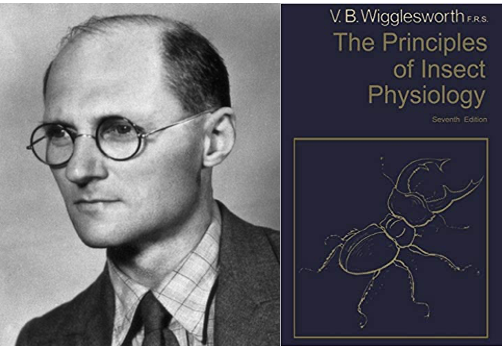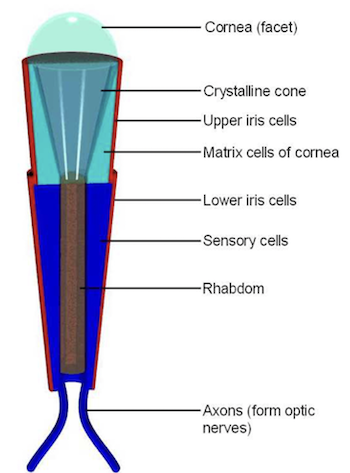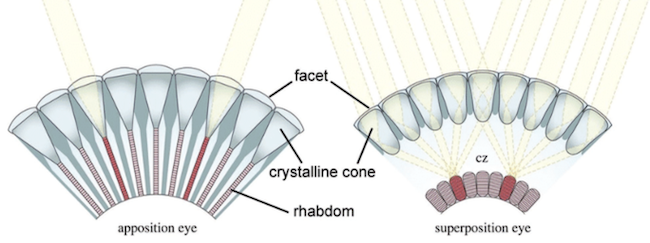👀 Insect Sense Organs
Visual, Auditory, Chemo, Mechano and Thermo receptors in insects
Which of the following statment is incorrect?
Insect Physiology
- It includes the physiology and biochemistry of insect organ systems.
- Father of insect physiology is Vincent Brian Wigglesworth.
- He wrote the book “Principles of Insect Physiology”.

Sense Organs
- The sense organs in an insect body are distributed on different parts and respond to a given stimulus such as light, sound, touch, chemicals etc.
- The sense organs may be classified as:
- Visual organs (or) photoreceptors
- Auditory organs (or) organs of hearing
- Chemoreceptors which respond to chemicals
- Mechano/Tactical receptors which respond to touch
- Thermo receptors which respond to temperature
Visual Organs or Photoreceptors
I. Compound Eyes

- These organs possess the ability to perceive light energy and able to produce a nerve impulse.
- The compound eyes may be completely absent in insects like Protura or they may remain reduced in endoparasites etc.
- The compound eyes are present on either side of the head capsule of an adult insect and also in the nymphs of Exopterygota.
- These are consisting of many individual units called
ommatidia. - Each ommatidia has a hexagonal face which, together, all form the surface of the compound eye. It is this individual ommatidium face that is called a facet.
- The number of ommatidia varies from 1 in the worker of ant, Ponera punctatissima to over 10,000 in the eyes of dragonflies.
- The shape of compound eye varies based on number of ommatidia. If the number of ommatidia is more, they remain closely packed and they attain a hexagonal shape. If they are few, they remain loosely packed and they attain circular shape.
- Compound eye is made up of two parts called optic part and sensory part.
- Optic part contains a cuticular lens called corneal lens secreted by
corneagenous cellsand crystalline cone covered by primary pigment cells. - Function of the optic part is to gather light.
- Sensory part contains six to ten visual cells called retinular cells covered by secondary pigment cells which collectively secrete a light sensitive rod at the centre called
rhabdom. Rhabdom contains light sensitive pigments calledrhodopsin(primary pigment). - Each ommatidium is covered by a ring of light absorbing pigmented cells (secondary pigment), which isolates an ommatidium from other.
- Nerve cells are clustered around the longitudinal axis of each ommatidium.

Types of ommatidia

- Apposition type (light tight):
- Due to the presence of primary pigment cells light cannot enter the adjacent cells. The mosaic image formed is very distinct. The image formed by the compound eye is of a series of opposed points of light of different intensities. This functions well in
diurnalinsects. - Eg: Butterflies
- Due to the presence of primary pigment cells light cannot enter the adjacent cells. The mosaic image formed is very distinct. The image formed by the compound eye is of a series of opposed points of light of different intensities. This functions well in
- Super position type:
- Primary pigment cells are absent allowing light to pass between adjacent ommatidia. Image fromed in this way are indistinct, bright and blurred. This type is seen in
nocturnaland crepuscular insects. - Eg: Moths
- Primary pigment cells are absent allowing light to pass between adjacent ommatidia. Image fromed in this way are indistinct, bright and blurred. This type is seen in
II. Simple eyes (or) ocelli
- Lateral ocelli (Stemmata): Visual organs of
holometabolouslarva. Structure is similar to ommatidium. It helps to detect form, colour and movement, and also to scan the environment. - Dorsal ocelli: Visual organs of nymph (
hemimetabolous) and it vary from 0-3 in numbers. It contains a single corneal lens with many visual cells individually secreting the rhabdomere. Dorsal ocelli perceive light to maintain diurnal rhythm and is not involved in image perception.
Auditory organs
- Insects are provided with structures (or) organs that are able to perceive the sound waves (or) the aquatic water currents. Among the organs of hearing, the auditory hairs, tympanal organ and Jhonston’s organ are important.
- Auditory hairs: These are present on the body of insects such as larvae of Lepidoptera which are developed from the modified epidermal cells. These respond to the sounds of air (or) water currents mediated by the hair sensillae (or) trichoid.
- Tympanal organ: This is a delicate organ (or) structure seen in the form of a cuticular membrane which internally consists of a ‘mullers’ organ. Tympanum is present one on either side of the 1st abdominal segment of short horned grasshoppers, on the base of foretibia in long horned grasshoppers and crickets, and on thorax or abdomen in Lepidoptera.
- Jhonston’s organ: It is present on the pedicel of antennae and functions as an auditory organ responding to air (or) water currents.
- Pilifer of hawk moths (sphingid moths): A unique auditory organ, sensitive to ultrasonic frequencies is found in the head of several species of Sphingidae.
Chemoreceptors
- Detect smell and taste.
- Detect chemical energy.
- Insect chemoreceptors are sensilla with one pore (uniporous) or more pores (multiporous).
- Uniporous chemorceptors mostly detect chemicals of solid and liquid form by contact and are called as gustatory receptor. Many sensor neurons located in antenna are of this type.
- Multiporous chemoreceptors detect chemicals in vapour form, at distant by smell and are called as olfactory receptor.
Thermoreceptors
- Detect heat.
- Present in poikilothermic insects and sensitive to temperature changes. In bed bug it is useful to locate the host utilizing the temperature gradient of the host.
Mechano receptors
- These detect mechanical forces.
- Trichoid sensilla: Hair like little sense organ. Sense cell associated with spur and seta. These cells are sensitive to touch and are located in antenna and trophi (mouth parts).
- Campaniform sensilla (Dome sensilla): Terminal end of these sensilla is rod like and inserted into dome shaped cuticula. These cells are sensitive to pressure and located in leg joints and wing bases.
- Chordotonal organ: The specialized sensory organs that receive vibrations are subcuticular mechano receptors called chordotonal organ. An organ consists of one-to-many scolopidia, each of which consists of cap cell, scolopale cell and dendrite. These organs are interceptors attached to both ends of body wall.
References
- Insecta - Introduction: K.N. Ragumoorithi, V. Balasurbramani & N. Natarajan
- A General Textbook of Entomology (9th edition, 1960) – A.D. Imms (Revised by Professor O.W. Richards and R.G. Davies). Butler & Tanner Ltd., Frome and London.
- The Insects- Structure and Function (4th Edition, 1998) – R.F. Chapman. Cambridge University Press
- https://www.amentsoc.org/
- Researchgate
- Wikipedia
Which of the following statment is incorrect?
Insect Physiology
- It includes the physiology and biochemistry of insect organ systems.
- Father of insect physiology is Vincent Brian Wigglesworth.
- He wrote the book “Principles of Insect Physiology”.

Sense Organs
- The sense organs in an insect body are distributed on different parts and respond to a given stimulus such as light, sound, touch, chemicals etc.
- The sense organs may be classified as:
- Visual organs (or) photoreceptors
- Auditory organs (or) organs of hearing
- Chemoreceptors which respond to chemicals
- Mechano/Tactical receptors which respond to touch
- Thermo receptors which respond to temperature
Visual Organs or Photoreceptors
I. Compound Eyes

- These organs possess the ability to perceive light energy and able to produce a …
Become Successful With AgriDots
Learn the essential skills for getting a seat in the Exam with
🦄 You are a pro member!
Only use this page if purchasing a gift or enterprise account
Plan
Rs
- Unlimited access to PRO courses
- Quizzes with hand-picked meme prizes
- Invite to private Discord chat
- Free Sticker emailed
Lifetime
Rs
1,499
once
- All PRO-tier benefits
- Single payment, lifetime access
- 4,200 bonus xp points
- Next Level
T-shirt shipped worldwide

Yo! You just found a 20% discount using 👉 EASTEREGG

High-quality fitted cotton shirt produced by Next Level Apparel